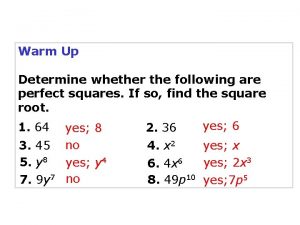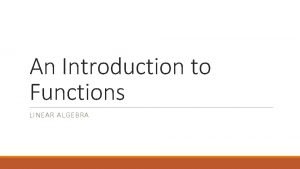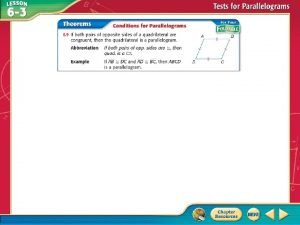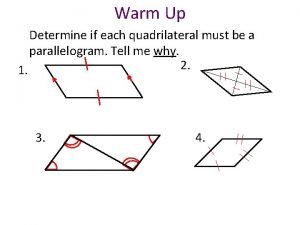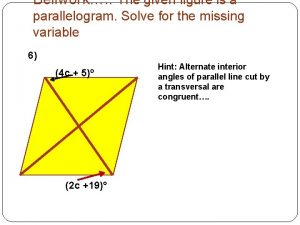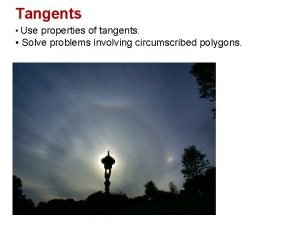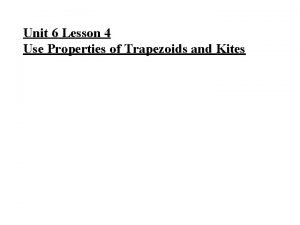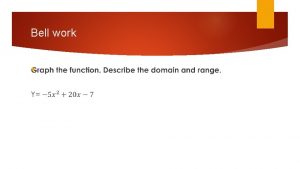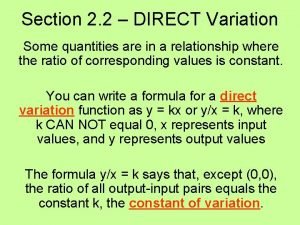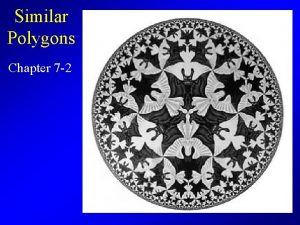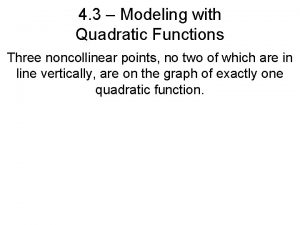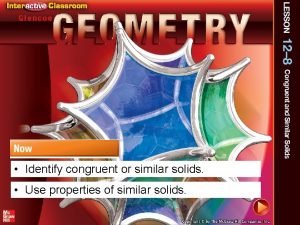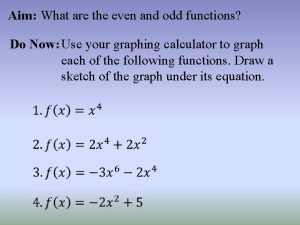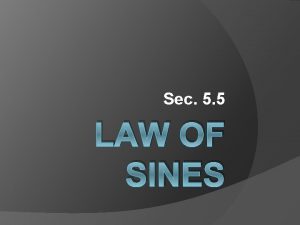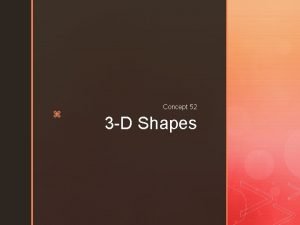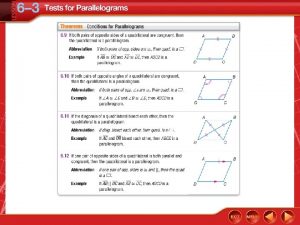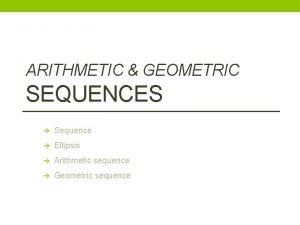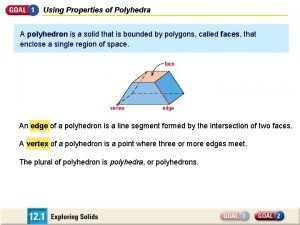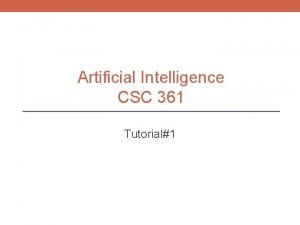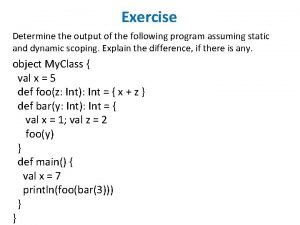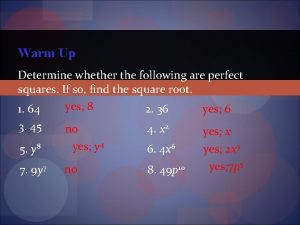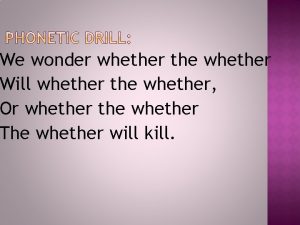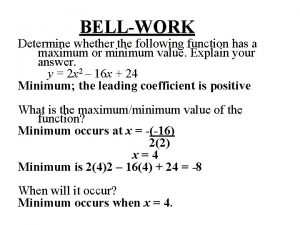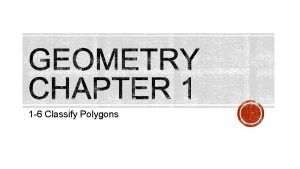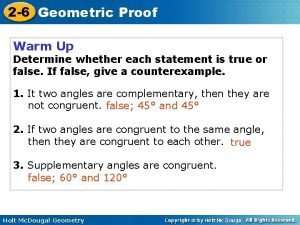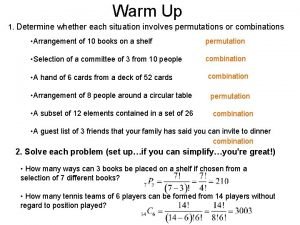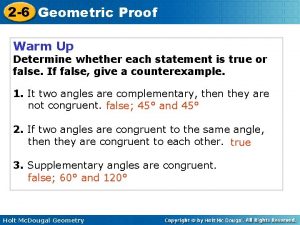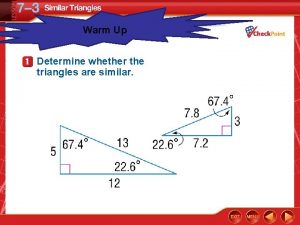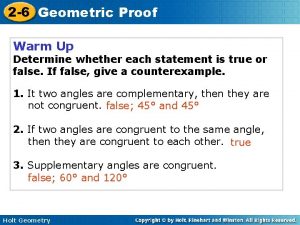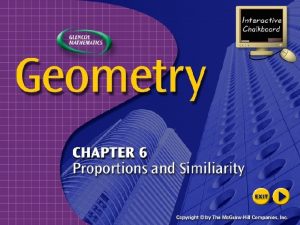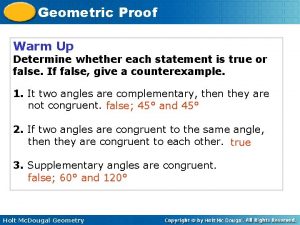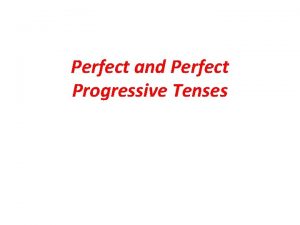Warm Up Determine whether the following are perfect






































- Slides: 38

Warm Up Determine whether the following are perfect squares. If so, find the square root. 1. 64 3. 45 5. y 8 7. 9 y 7 yes; 8 no yes; y 4 no 2. 36 yes; 6 4. x 2 yes; x yes; 2 x 3 6. 4 x 6 8. 49 p 10 yes; 7 p 5

Objectives Factor perfect-square trinomials. Factor the difference of two squares.

A trinomial is a perfect square if: • The first and last terms are perfect squares. • The middle term is two times one factor from the first term and one factor from the last term. 9 x 2 3 x • + 12 x + 4 3 x 2(3 x • 2) 2 • 2


Example 1 A: Recognizing and Factoring Perfect. Square Trinomials Determine whether each trinomial is a perfect square. If so, factor. If not explain. 9 x 2 – 15 x + 64 3 x 3 x 2(3 x 8) 8 8 2(3 x 8) ≠ – 15 x. 9 x 2 – 15 x + 64 is not a perfect-square trinomial because – 15 x ≠ 2(3 x 8).

Example 1 B: Recognizing and Factoring Perfect. Square Trinomials Determine whether each trinomial is a perfect square. If so, factor. If not explain. 81 x 2 + 90 x + 25 9 x ● 9 x 2(9 x ● 5) 5 ● 5 The trinomial is a perfect square. Factor.

Example 1 B Continued Determine whether each trinomial is a perfect square. If so, factor. If not explain. Method 2 Use the rule. 81 x 2 + 90 x + 25 a = 9 x, b = 5 (9 x)2 + 2(9 x)(5) + 52 Write the trinomial as a 2 + 2 ab + b 2. (9 x + 5)2 Write the trinomial as (a + b)2.

Example 1 C: Recognizing and Factoring Perfect. Square Trinomials Determine whether each trinomial is a perfect square. If so, factor. If not explain. 36 x 2 – 10 x + 14 The trinomial is not a perfect-square because 14 is not a perfect square. 36 x 2 – 10 x + 14 is not a perfect-square trinomial.

Check It Out! Example 1 a Determine whether each trinomial is a perfect square. If so, factor. If not explain. x 2 + 4 x + 4 x x 2(x 2) 2 2 The trinomial is a perfect square. Factor.

Check It Out! Example 1 a Continued Determine whether each trinomial is a perfect square. If so, factor. If not explain. Method 1 Factor. x 2 + 4 x + 4 Factors of 4 Sum (1 and 4) 5 (2 and 2) 4 (x + 2) = (x + 2)2

Check It Out! Example 1 b Determine whether each trinomial is a perfect square. If so, factor. If not explain. x 2 – 14 x + 49 x x 2(x 7) 7 7 The trinomial is a perfect square. Factor.

Check It Out! Example 1 b Continued Determine whether each trinomial is a perfect square. If so, factor. If not explain. Method 2 Use the rule. x 2 – 14 x + 49 (x)2 – 2(x)(7) + 72 (x – 7)2 a = 1, b = 7 Write the trinomial as a 2 – 2 ab + b 2. Write the trinomial as (a – b)2.

Check It Out! Example 1 c Determine whether each trinomial is a perfect square. If so, factor. If not explain. 9 x 2 – 6 x + 4 9 x 2 3 x 3 x – 6 x 2(3 x 2) +4 2 2 2(3 x)(4) ≠ – 6 x 9 x 2 – 6 x + 4 is not a perfect-square trinomial because – 6 x ≠ 2(3 x 2)

Example 2: Problem-Solving Application A square piece of cloth must be cut to make a tablecloth. The area needed is (16 x 2 – 24 x + 9) in 2. The dimensions of the cloth are of the form cx – d, where c and d are whole numbers. Find an expression for the perimeter of the cloth. Find the perimeter when x = 11 inches.

Example 2 Continued 1 Understand the Problem The answer will be an expression for the perimeter of the cloth and the value of the expression when x = 11. List the important information: • The tablecloth is a square with area (16 x 2 – 24 x + 9) in 2. • The side length of the tablecloth is in the form cx – d, where c and d are whole numbers.

Example 2 Continued 2 Make a Plan The formula for the area of a square is area = (side)2. Factor 16 x 2 – 24 x + 9 to find the side length of the tablecloth. Write a formula for the perimeter of the tablecloth, and evaluate the expression for x = 11.

Example 2 Continued 3 Solve a = 4 x, b = 3 16 x 2 – 24 x + 9 (4 x)2 – 2(4 x)(3) + (4 x – 3)2 32 Write the trinomial as a 2 – 2 ab + b 2. Write the trinomial as (a – b)2. 16 x 2 – 24 x + 9 = (4 x – 3) The side length of the tablecloth is (4 x – 3) in.

Example 2 Continued Write a formula for the perimeter of the tablecloth. = 4(4 x – 3) Write the formula for the perimeter of a square. Substitute the side length for s. = 16 x – 12 Distribute 4. P = 4 s An expression for the perimeter of the tablecloth in inches is 16 x – 12.

Example 2 Continued Evaluate the expression when x = 11. P = 16 x – 12 = 16(11) – 12 Substitute 11 for x. = 164 When x = 11 in. the perimeter of the tablecloth is 164 in.

Example 2 Continued 4 Look Back For a square with a perimeter of 164, the side length is. and the area is 41 2 = 1681 in 2. Evaluate 16 x 2 – 24 x + 9 for x = 11. 16(11)2 – 24(11) + 9 1936 – 264 + 9 1681

Check It Out! Example 2 What if …? A company produces square sheets of aluminum, each of which has an area of (9 x 2 + 6 x + 1) m 2. The side length of each sheet is in the form cx + d, where c and d are whole numbers. Find an expression in terms of x for the perimeter of a sheet. Find the perimeter when x = 3 m.

Check It Out! Example 2 Continued 1 Understand the Problem The answer will be an expression for the perimeter of a sheet and the value of the expression when x = 3. List the important information: • A sheet is a square with area (9 x 2 + 6 x + 1) m 2. • The side length of a sheet is in the form cx + d, where c and d are whole numbers.

Check It Out! Example 2 Continued 2 Make a Plan The formula for the area of a sheet is area = (side)2 Factor 9 x 2 + 6 x + 1 to find the side length of a sheet. Write a formula for the perimeter of the sheet, and evaluate the expression for x = 3.

Check It Out! Example 2 Continued 3 Solve 9 x 2 + 6 x + 1 a = 3 x, b = 1 (3 x)2 + 2(3 x)(1) + 12 Write the trinomial as a 2 + 2 ab + b 2. (3 x + 1)2 Write the trinomial as (a + b)2. 9 x 2 + 6 x + 1 = (3 x + 1) The side length of a sheet is (3 x + 1) m.

Check It Out! Example 2 Continued Write a formula for the perimeter of the aluminum sheet. P = 4 s Write the formula for the perimeter of a square. = 4(3 x + 1) Substitute the side length for s. = 12 x + 4 Distribute 4. An expression for the perimeter of the sheet in meters is 12 x + 4.

Check It Out! Example 2 Continued Evaluate the expression when x = 3. P = 12 x + 4 = 12(3) + 4 Substitute 3 for x. = 40 When x = 3 m. the perimeter of the sheet is 40 m.

Check It Out! Example 2 Continued 4 Look Back For a square with a perimeter of 40, the side length is m and the area is 102 = 100 m 2. Evaluate 9 x 2 + 6 x + 1 for x = 3 9(3)2 + 6(3) + 1 81 + 18 + 1 100

In Chapter 7 you learned that the difference of two squares has the form a 2 – b 2. The difference of two squares can be written as the product (a + b)(a – b). You can use this pattern to factor some polynomials. A polynomial is a difference of two squares if: • There are two terms, one subtracted from the other. • Both terms are perfect squares. 4 x 2 – 9 2 x 2 x 3 3


Reading Math Recognize a difference of two squares: the coefficients of variable terms are perfect squares, powers on variable terms are even, and constants are perfect squares.

Example 3 A: Recognizing and Factoring the Difference of Two Squares Determine whether each binomial is a difference of two squares. If so, factor. If not, explain. 3 p 2 – 9 q 4 3 q 2 3 p 2 is not a perfect square. 3 p 2 – 9 q 4 is not the difference of two squares because 3 p 2 is not a perfect square.

Example 3 B: Recognizing and Factoring the Difference of Two Squares Determine whether each binomial is a difference of two squares. If so, factor. If not, explain. 100 x 2 – 4 y 2 10 x 2 y 2 y (10 x)2 – (2 y)2 (10 x + 2 y)(10 x – 2 y) The polynomial is a difference of two squares. a = 10 x, b = 2 y Write the polynomial as (a + b)(a – b). 100 x 2 – 4 y 2 = (10 x + 2 y)(10 x – 2 y)

Example 3 C: Recognizing and Factoring the Difference of Two Squares Determine whether each binomial is a difference of two squares. If so, factor. If not, explain. x 4 – 25 y 6 The polynomial is a difference x 2 5 y 3 of two squares. (x 2)2 – (5 y 3)2 a = x 2, b = 5 y 3 Write the polynomial as (x 2 + 5 y 3)(x 2 – 5 y 3) (a + b)(a – b). x 4 – 25 y 6 = (x 2 + 5 y 3)(x 2 – 5 y 3)

Check It Out! Example 3 a Determine whether each binomial is a difference of two squares. If so, factor. If not, explain. 1 – 4 x 2 1 1 2 x 2 x (1) – (2 x)2 (1 + 2 x)(1 – 2 x) 1 – 4 x 2 = (1 + 2 x)(1 – 2 x) The polynomial is a difference of two squares. a = 1, b = 2 x Write the polynomial as (a + b)(a – b).

Check It Out! Example 3 b Determine whether each binomial is a difference of two squares. If so, factor. If not, explain. p 8 – 49 q 6 The polynomial is a difference of two squares. (p 4)2 – (7 q 3)2 a = p 4, b = 7 q 3 (p 4 + 7 q 3)(p 4 – 7 q 3) Write the polynomial as (a + b)(a – b). p 8 – 49 q 6 = (p 4 + 7 q 3)(p 4 – 7 q 3) p 4 – p 4 7 q 3 – 7 q 3

Check It Out! Example 3 c Determine whether each binomial is a difference of two squares. If so, factor. If not, explain. 16 x 2 – 4 y 5 4 x 4 y 5 is not a perfect square. 16 x 2 – 4 y 5 is not the difference of two squares because 4 y 5 is not a perfect square.

Lesson Quiz: Part I Determine whether each trinomial is a perfect square. If so factor. If not, explain. 1. 64 x 2 – 40 x + 25 Not a perfect-square trinomial because – 40 x ≠ 2(8 x 5). 2. 121 x 2 – 44 x + 4 (11 x – 2)2 3. 49 x 2 + 140 x + 100 (7 x 2 + 10)2 4. A fence will be built around a garden with an area of (49 x 2 + 56 x + 16) ft 2. The dimensions of the garden are cx + d, where c and d are whole numbers. Find an expression for the P = 28 x + 16; 156 ft perimeter when x = 5.

Lesson Quiz: Part II Determine whether the binomial is a difference of two squares. If so, factor. If not, explain. 5. 9 x 2 – 144 y 4 (3 x + 12 y 2)(3 x – 12 y 2) 6. 30 x 2 – 64 y 2 Not a difference of two squares; 30 x 2 is not a perfect square 7. 121 x 2 – 4 y 8 (11 x + 2 y 4)(11 x – 2 y 4)
 Insidan region jh
Insidan region jh Determine whether each trinomial is a perfect square
Determine whether each trinomial is a perfect square Determine whether the following relation is a function.
Determine whether the following relation is a function. Whether the weather is fine
Whether the weather is fine Determine whether the quadrilateral is a parallelogram
Determine whether the quadrilateral is a parallelogram Determine whether the quadrilateral is a parallelogram.
Determine whether the quadrilateral is a parallelogram. Multiplying and dividing matrices
Multiplying and dividing matrices Determine whether the quadrilateral is a parallelogram.
Determine whether the quadrilateral is a parallelogram. How to solve this problem
How to solve this problem Notes 6-6: properties of kites and trapezoids
Notes 6-6: properties of kites and trapezoids Determine whether a function is even or odd
Determine whether a function is even or odd Determine whether y varies directly with x
Determine whether y varies directly with x Determine whether the sequence is arithmetic or not
Determine whether the sequence is arithmetic or not 7-2 similar polygons
7-2 similar polygons Determine whether a quadratic model exists
Determine whether a quadratic model exists Congruent solids
Congruent solids How to determine whether a function is odd or even
How to determine whether a function is odd or even State whether the given measurements determine zero
State whether the given measurements determine zero Solid
Solid Identify parallelograms
Identify parallelograms Determine whether each word
Determine whether each word Geometric sequence recursive formula
Geometric sequence recursive formula 1-7 three dimensional figures
1-7 three dimensional figures Determine whether the solid is a polyhedron
Determine whether the solid is a polyhedron Past perfect present perfect future perfect
Past perfect present perfect future perfect Playing a decent game of table tennis (ping-pong).
Playing a decent game of table tennis (ping-pong). Read each of the following situations
Read each of the following situations Presente perfecto del subjuntivo
Presente perfecto del subjuntivo Perfect trinomial
Perfect trinomial What is the output of the following program:
What is the output of the following program: ưu thế lai là gì
ưu thế lai là gì Thẻ vin
Thẻ vin Cái miệng bé xinh thế chỉ nói điều hay thôi
Cái miệng bé xinh thế chỉ nói điều hay thôi Các châu lục và đại dương trên thế giới
Các châu lục và đại dương trên thế giới Bổ thể
Bổ thể Từ ngữ thể hiện lòng nhân hậu
Từ ngữ thể hiện lòng nhân hậu Tư thế ngồi viết
Tư thế ngồi viết Giọng cùng tên là
Giọng cùng tên là Thơ thất ngôn tứ tuyệt đường luật
Thơ thất ngôn tứ tuyệt đường luật

